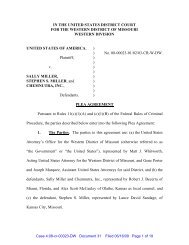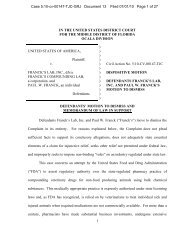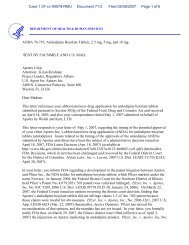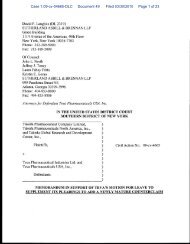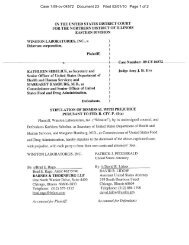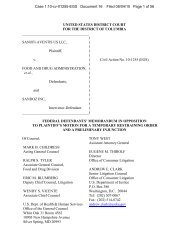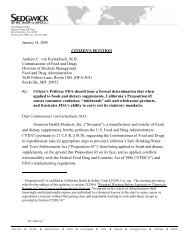first edition (1980) of the Orange Book - FDA Law Blog
first edition (1980) of the Orange Book - FDA Law Blog
first edition (1980) of the Orange Book - FDA Law Blog
Create successful ePaper yourself
Turn your PDF publications into a flip-book with our unique Google optimized e-Paper software.
FOOD AND DRUG ADMINI STRATIONAPPROVED PRFS::RIPTION DRtX; PRODUCTS- With Therapeutic Equivalence Evaluations -I. PREFACEA. INTRODUCTIONThe Approved Prescription Drug Products list (<strong>the</strong> List) provides a list<strong>of</strong> currently marketed prescription drug products that have been approved formarketing on <strong>the</strong> basis <strong>of</strong> safety and effectiveness by <strong>the</strong> Food and DrugAdministration (<strong>FDA</strong>). In addition, it contains <strong>the</strong>rapeutic equivalenceevaluations for multiple source drug products. These evaluations have beenprepared to pvomote public education in <strong>the</strong> area <strong>of</strong> drug product selection,to foster containment <strong>of</strong> health costs, and to serve state health agencies in<strong>the</strong> administration <strong>of</strong> <strong>the</strong>ir drug product selection laws.For several years <strong>the</strong>re has been a trend toward repeal <strong>of</strong> antisubstitutionlegislation that once was common in most States. In addition,most States have adopted laws intended to encourage or mandate <strong>the</strong> substitution<strong>of</strong> one product <strong>of</strong> a particular drug entity for ano<strong>the</strong>r, with <strong>the</strong> intent<strong>of</strong> saving money for <strong>the</strong> consumer and containing costs in drug procurementand medical reimbursement programs. These State laws generally require thatei<strong>the</strong>r substitution be limited to drugs on a specific list (<strong>the</strong> positiveformulary approach) or that substitution be permitted for all drugs exceptthose prohibited by a particular list (<strong>the</strong> negative formulary approach). .A number <strong>of</strong> States have sought <strong>the</strong> assistance <strong>of</strong> <strong>FDA</strong> in preparing bothposi ti ve and negati ve formular ies. For example, on January 23, 1978 <strong>FDA</strong>responded to a request fDOm <strong>the</strong> New York State Health Department to evaluate<strong>the</strong>ir list <strong>of</strong> drug products for <strong>the</strong>rapeutic equivalence. Subsequently, asimilar evaluation was made <strong>of</strong> a list suJ:mi tted by <strong>the</strong> State <strong>of</strong> Illinois.The basic policies awlied in evaluating <strong>the</strong>se lists for <strong>the</strong> States <strong>of</strong> NewYork and Illioois are identical to <strong>the</strong> policies applied in developing thisList.Because <strong>of</strong> <strong>the</strong> number <strong>of</strong> requests for assistance in developing druglists fran o<strong>the</strong>r States, it became awarent that <strong>FDA</strong> could not serve <strong>the</strong>needs <strong>of</strong> each State on an individual basis. The agency also recognized thata single list based on common policies would be preferable to attempting toevaluate drug products on <strong>the</strong> basis <strong>of</strong> differing definitions and criteria invarious State laws. As a result, on May 31, 1978, <strong>the</strong> Camnissioner <strong>of</strong> Foodand Drugs sent a letter to <strong>of</strong>ficials <strong>of</strong> all States informing <strong>the</strong>m <strong>of</strong> <strong>FDA</strong>'s



